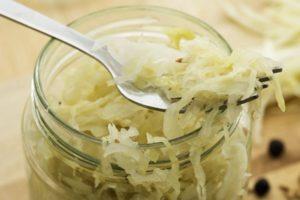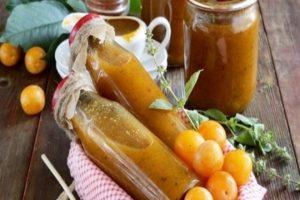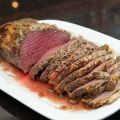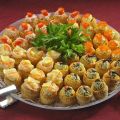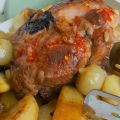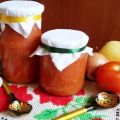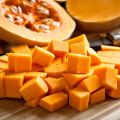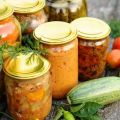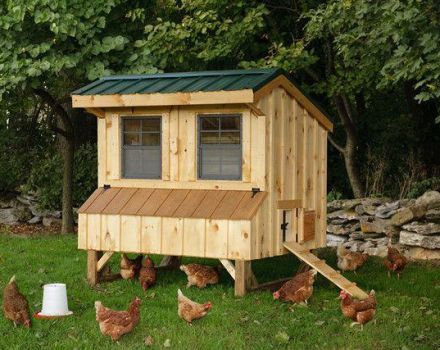10 best recipes for home canning in an autoclave
Thanks to the assortment of recipes for an autoclave for home canning, housewives can quickly and efficiently make blanks that will delight households throughout the winter. Due to the equipment, the laborious process of sterilization is optimized and the quality level of the twist is raised. Each recipe can be refined independently, based on taste preferences.
Features of canning for the winter using an autoclave
The main advantage of the autoclave is that the temperature in it reaches 120 degrees Celsius. Thanks to this, the canning procedure takes a minimum amount of time. The benefits of products, taste and aroma are preserved for a long time.
Types of devices
By design type, devices are divided into:
- Vertical models - used in the food industry, for laboratory purposes, for the implementation of chemical reactions in medicine.
- Horizontal - used for wood processing, lamination.
Autoclaves are made of two types of metals:
- Black is an inexpensive option that is not completely safe for cooking.
- Made of stainless steel - lasts up to 50 years, allows the use of various conservation technologies.
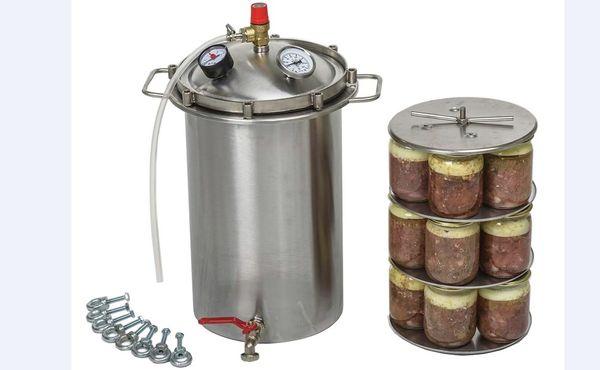
By the type of heating, devices are divided into:
- external heating - by fire or gas;
- electrical.
The sizes of autoclaves can be different - from small models for 5 cans of 0.5 liters to 1000 of the same cans. The neck diameter is also varied. The most common for household use is 15.9 and 21 centimeters.
Autoclave device
The device is a steam sterilizer, which includes a thermometer, manometer, heat source, outlet and inlet taps. The active agent is hot steam under pressure. Loading of materials takes place in bix.
The operation of the device is controlled by a thermometer and a manometer.
The main modes of sterilization are distinguished:
- 60 minutes - at an atmospheric pressure of 1.1;
- 45 minutes - at 1.5;
- 30 minutes - at 2.
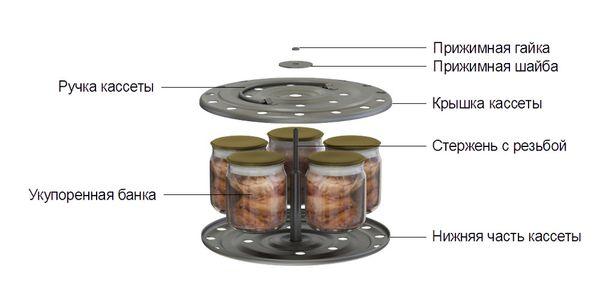
Preparation for work
The workflow involves the following procedure:
- Prepare clean jars.
- Place a thick cloth on the bottom of the appliance.
- Put the jars on the fabric in 2 layers.
- Fill the autoclave with water.
- Set initial pressure.
- Heat the device.
Autoclave recipes
There are many recipes for preservation prepared using an autoclave. Various types of meat, cereals, vegetables are often used.

Canned meat
To create a beef stock in your own juice, you need the following ingredients:
- beef meat;
- brain bones;
- fat;
- onion;
- carrot;
- zira;
- Bay leaf;
- allspice peas;
- salt.
Preparation:
- Boil the broth based on beef bones.
- Cut the meat into small cubes, fry in a pan.
- Put spices and chopped vegetables at the bottom of the jars.
- Place the meat tightly in a container.
- Pour in broth.
- Close with lids.
- Simmer in an autoclave for 115 minutes at a temperature of 117 degrees.
An indicator of the quality of canned food is the formation of a jelly-like mass in the jar after cooling.
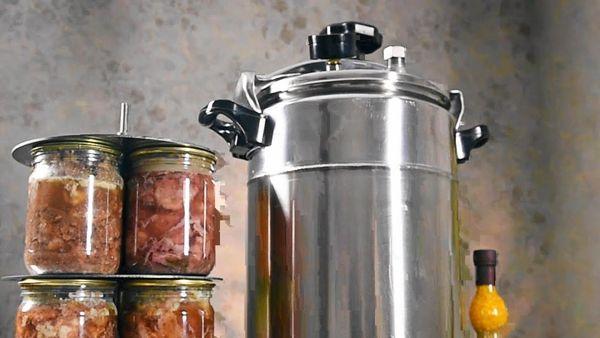
Canned poultry meat
To create a tasty preparation, chicken, duck, goose, turkey meat is used to choose from. The following components are needed:
- 1 kilogram of meat;
- 1 spoon of salt;
- black pepper hammers;
- 2 onions.
Step by step actions:
- Cut poultry meat into small pieces, mix with salt and chopped onion.
- Put in a container and roll up.
- Send the jars to the autoclave for 30 minutes at 100-110 degrees.
If chicken meat is used, add 6 tablespoons of water for each liter. Fat is present in other types of poultry meat.
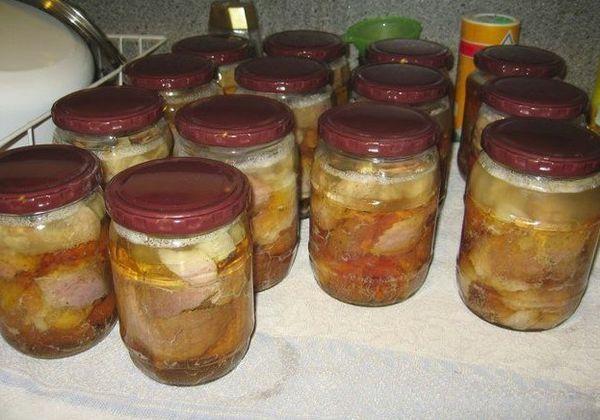
From fish
For the manufacture of canned food, the use of any fish is popular: bream, mackerel, sprat, perch, silver carp, pike, gobies. For a recipe with an output of 1 can of 0.5 liters, products are needed in the following volume:
- 0.5 kilograms of cleaned fish;
- 1 teaspoon salt
- 5 black peppercorns;
- 1 tablespoon sunflower oil
- seasoning to taste.
Processes:
- Cut the fish into small pieces.
- Place the main component on the bottom of the glass container.
- Sprinkle with salt and spices.
- Layer the fish up to the top of the jar.
- Roll up and autoclave for processing.
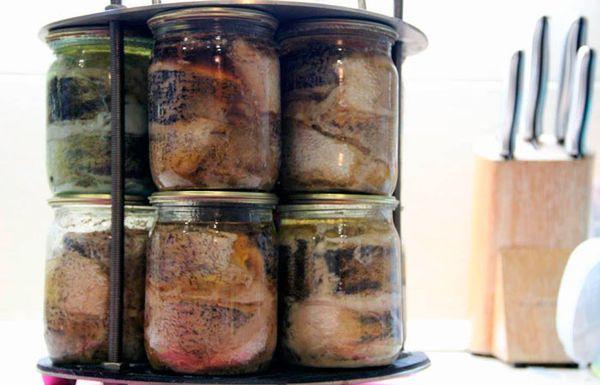
Vegetable
Due to the correct canning of vegetables in an autoclave, you can preserve a large number of useful elements that will become full-fledged vitamin sources. For a classic recipe, you need to prepare products:
- 3 kilograms of eggplant;
- 2 kilograms of bell pepper;
- 1 kilogram of tomatoes and carrots;
- 500 grams of onions;
- 2 tablespoons of salt;
- 150 milliliters of vegetable oil.
Cooking steps:
- Peel and cut the eggplant into rings. Season with salt and leave for 3 hours.
- Grind the rest of the vegetables.
- Fry each component separately in a pan with oil.
- Put the processed mixed vegetables and eggplant in layers in prepared clean jars.
- Sterilize closed jars in an autoclave for 15-20 minutes.
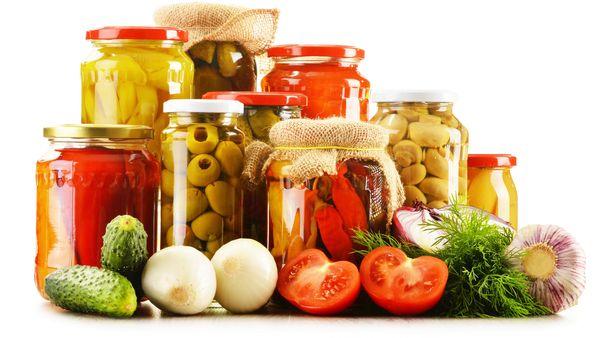
Tomato sauces
For a hot tomato sauce in a volume of 1 kilogram, the following components are used:
- 2800 grams of tomatoes;
- 23 grams of salt;
- 15 grams of sugar;
- clove of garlic;
- ground black pepper;
- allspice;
- 3 milligrams of cloves
- nutmeg;
- vinegar essence 80%;
- cinnamon.
Recipe:
- Washed and dried tomatoes mince.
- Cook over low heat until the mass is reduced by 2-3 times.
- Chop carrots, peppers and garlic.
- Combine all the elements and cook for 30 minutes over low heat, add the vinegar essence at the end.
- Keep closed jars in an autoclave for sterilization.
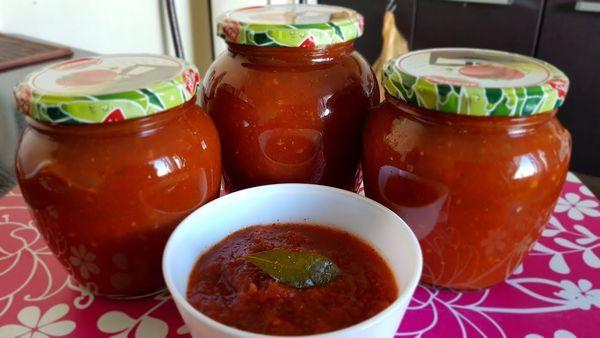
Mushrooms
To make several 0.5 liter jars with pickled mushrooms, you need to prepare the products:
- 1 kilogram of honey agarics;
- for 1 liter of water - 1 tablespoon of salt, sugar and vinegar;
- 2 bay leaves;
- 3 pieces of cloves;
- 3-4 cloves of garlic;
- sunflower oil.
Cooking method:
- Sort out and rinse the mushrooms.
- Pour honey mushrooms with water, salt. Boil for 7-10 minutes.
- Drain the liquid. Fill with clean water. Cook for 30 minutes.
- Strain with a colander.
- For the marinade, you need to combine all of the above spices in warm water.
- Cook the mushrooms in the marinade for 5-7 minutes.
- Arrange the mushrooms in the jars. Pour marinade over. Add 5-7 drops of oil to each container.
- Autoclave the workpieces at 110 degrees Celsius for 10 minutes.
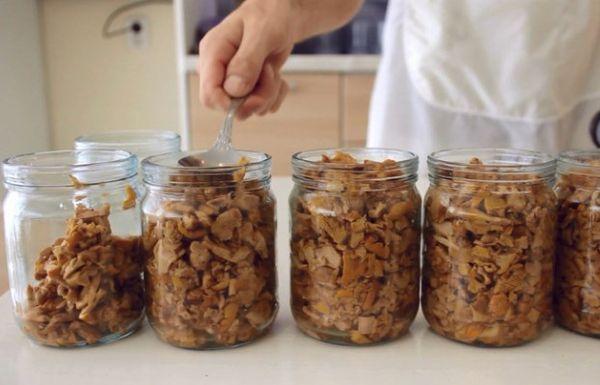
Pork stew
Required Ingredients:
- 0.5 kilograms of pork;
- 1 onion;
- 3 black peppercorns;
- 1 teaspoon salt
- water;
- 1 bay leaf.
Recipe:
- Sprinkle with salt and water over the diced meat.
- Put spices at the bottom of the container, fill with meat, leaving an empty space of 2 centimeters to the top.
- Roll up and leave in an autoclave at 110 degrees for 40 minutes.
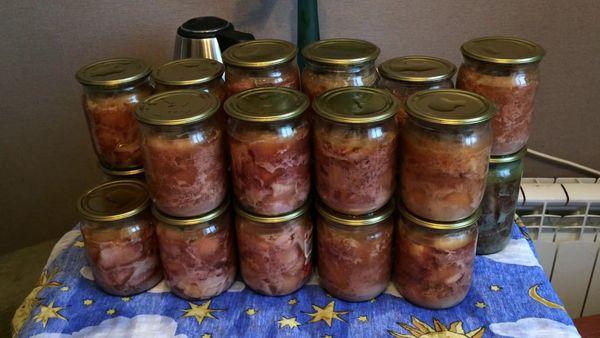
Rice porridge with pork
For an original dish you will need:
- 2 kilograms of pork;
- 200 grams of lard;
- 120 grams of rice for each can;
- 3 onions;
- 2 carrots;
- salt;
- allspice;
- sunflower oil;
- barberry;
- zira;
- lavrushka.
Step by step execution:
- Pass the washed meat through a large meat grinder or cut into small cubes.
- Melt the lard in a frying pan.
- Saute chopped onions and carrots.
- Rinse the cereals with water.
- At the bottom of the container, place ½ bay leaf, frying, rice, a few pieces of meat, a spoonful of lard, salt and spices.
- Pour boiling water over the jar. Close the lid.
- Cook in an autoclave for 35-40 minutes at 120 degrees.
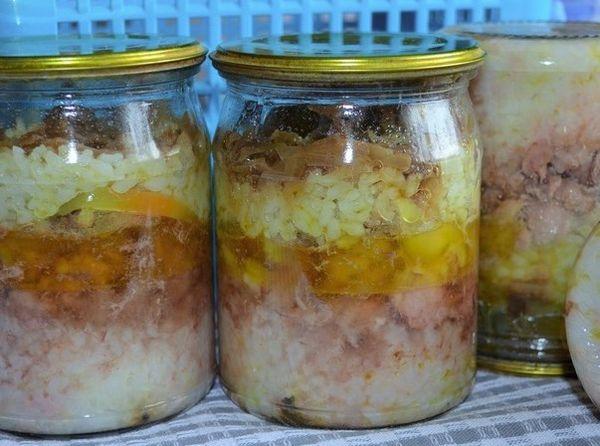
Barley with lamb
The following elements are recommended:
- 0.5 kilograms of lamb;
- 2 glasses of pearl barley;
- 1 each onion, carrot and sweet pepper;
- 1 teaspoon of mustard beans
- 2 teaspoons of Italian spice blend
- salt;
- oil for frying.
Cooking steps:
- Grind the meat.
- Finely chop washed and peeled vegetables. Fry in a pan with butter for 3-5 minutes.
- Fry the lamb in a pan until golden brown.
- Put meat, salt with spices, pearl barley, vegetables in glass jars.
- Tighten with lids.
- Leave to sterilize in an autoclave for 40 minutes at 120 degrees.
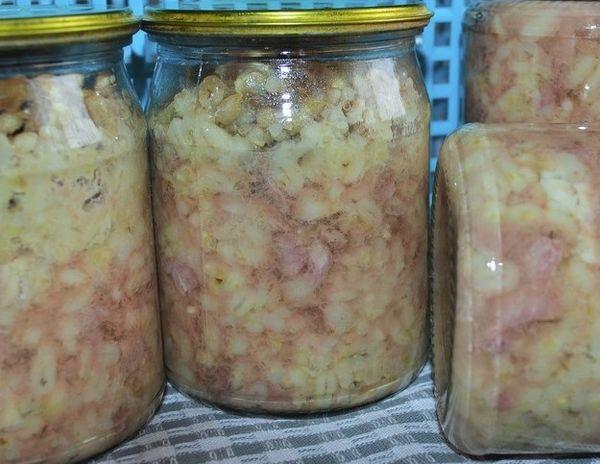
How and how much you can store the finished product at home
The workpieces should be stored in a dark, dry room with a temperature of no more than 10 degrees. Banks should be checked regularly for signs of bloating and deterioration. If suspicious containers of the same batch of twists are found, re-sterilization should be performed.
The optimal shelf life is 2-3 years. For better storage, grease the jars. Experienced housewives recommend signing for convenience conservation, indicating the date of manufacture and the name of the blank.
